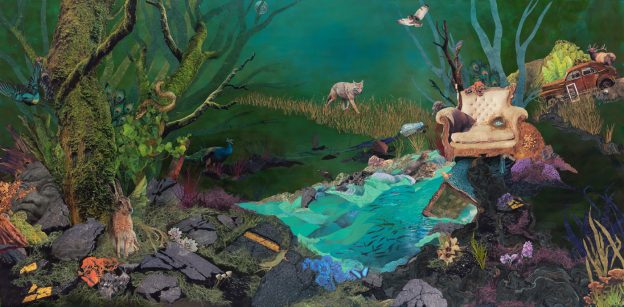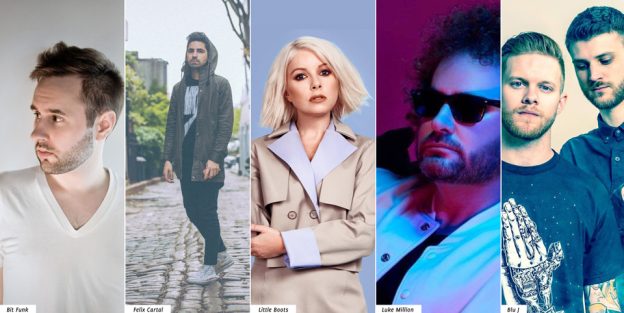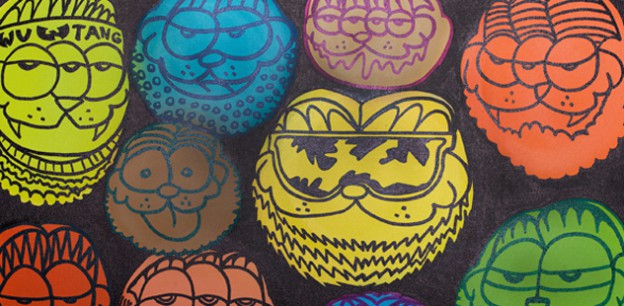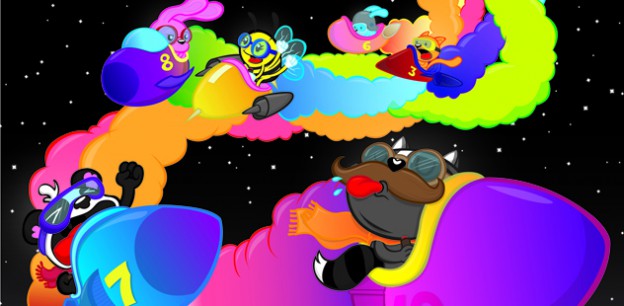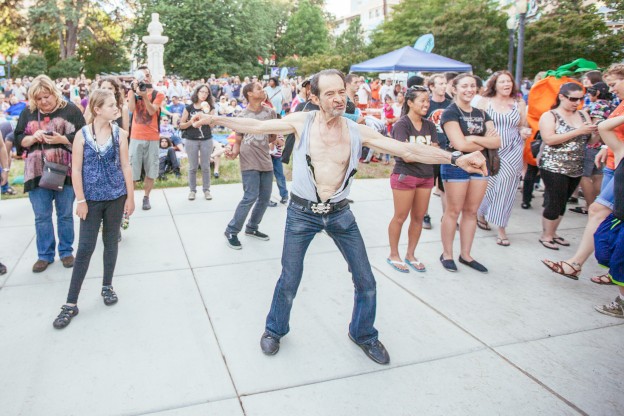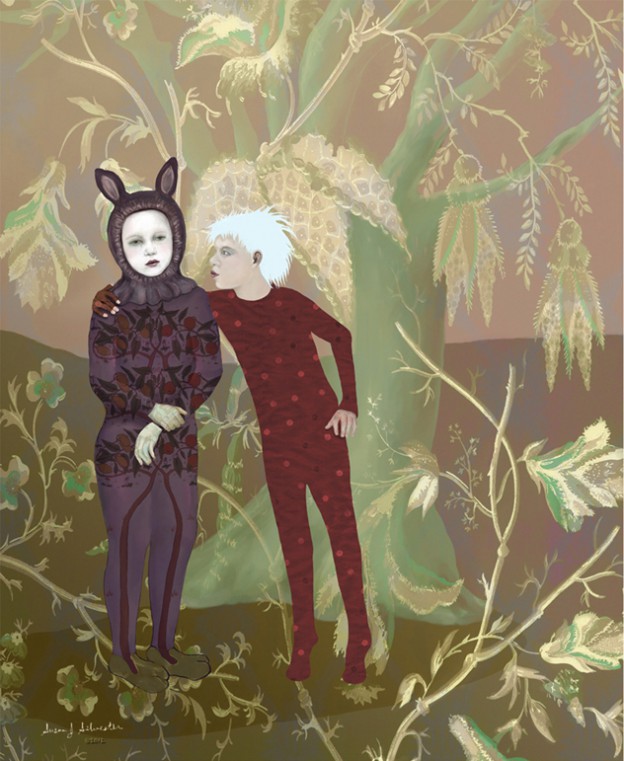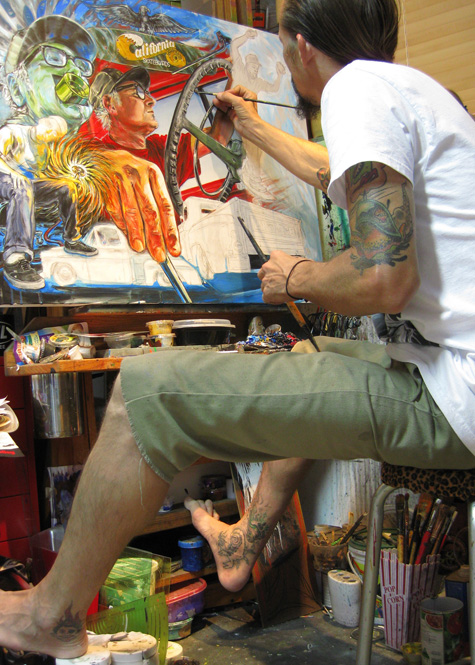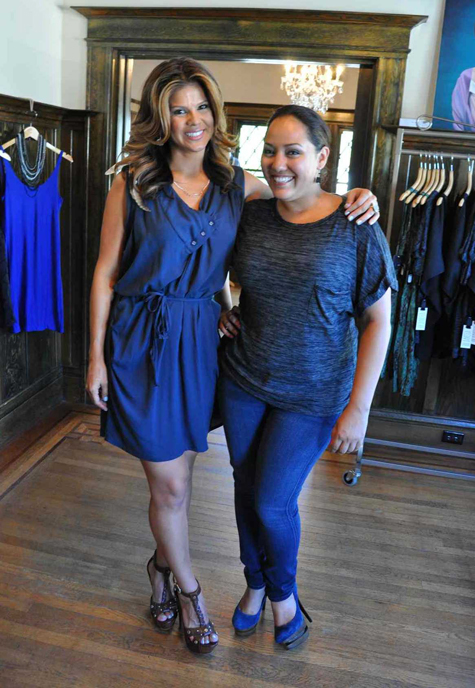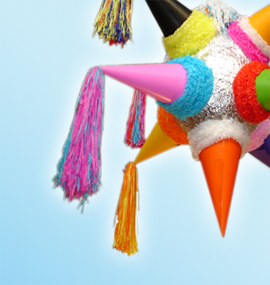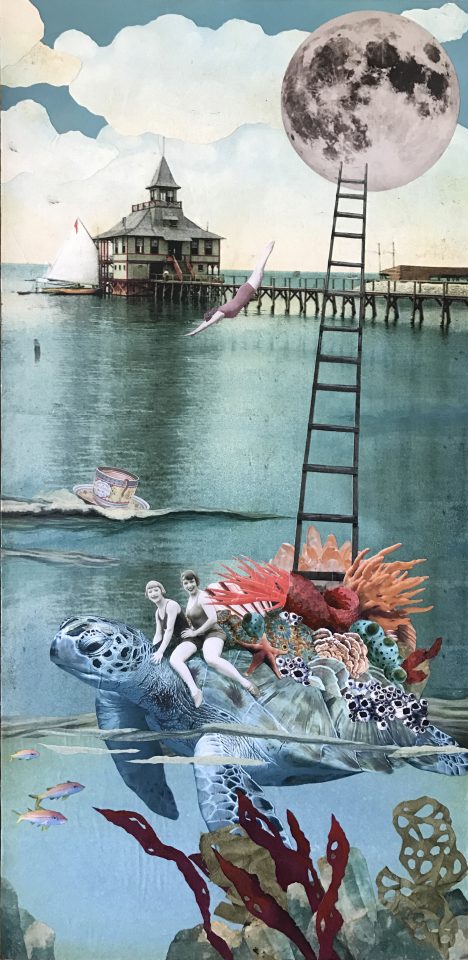
Recall the first moments of waking, when, adrift in the mental flotsam left over from a night of vivid dreaming, you try and sort the pieces together. The half-remembered places and in-between entities that had charged through the landscape of your imagination with such jarring solidity now burn away like soap bubbles in the sunlight of logic. What allows us to weave these strange symbols and portents together so seamlessly in the sleeping hours? In our best efforts to reconstruct a dream, the results inevitably resemble a collage—fragments of wonder, alarm and mystery snatched from the subconscious.
For Angela Tannehill, the results are more seamless than most. In the two-odd years since she began working on her mixed media pieces—found cutouts layered and blended into textured background painting—she has honed a special knack for creating surrealist landscapes possessed of a storytelling power.
A few months back at ArtStreet, one could see small crowds engrossed in the story told by Tannehill’s largest work to date, After Us. It depicts an edenic wilderness of lush growth and harmonious life: peacocks, wolves, hares and snakes frolicking among the littered remnants of human craftsmanship—an ornate chair, a vintage automobile—gracefully decaying in the new unpeopled paradigm. One of the standout works at the month-long event, it left an impression of depth and animacy, as if it might start moving once all eyes are off the canvas. Her back catalog offers the chance to go deeper into this peculiar realm: Manta rays and starlings fly together in the dawn sky, while polar bears and hummingbirds emerge from portals into space. Though architectural wreckage and a disembodied human presence can be found scattered throughout these constellational works, they are always in some way subsumed by the elements; nature has figured largest in her choice of subject, an enduring influence from a childhood in the countryside.
When she’s not piecing together pipedream perspectives and hypnagogic hybrids, Tannehill harnesses her creative powers for community impact, a vocation she labels “design for do-gooders.” This includes designing promotional material for nonprofits like Sutter Health, and creating around 50 book covers for the youth literacy outreach group 916 Ink, which helps young people tell and publish their stories. If the amount of effort expended in promoting creativity in others has a feedback effect, it has surely reverberated loudly in Tannehill’s work, driving her to create more and amplify outward her normally introverted nature.
We recently caught up with Angela to find out about the ArtStreet experience, the value of community involvement and the virtue of the unexpected in her chosen artform.
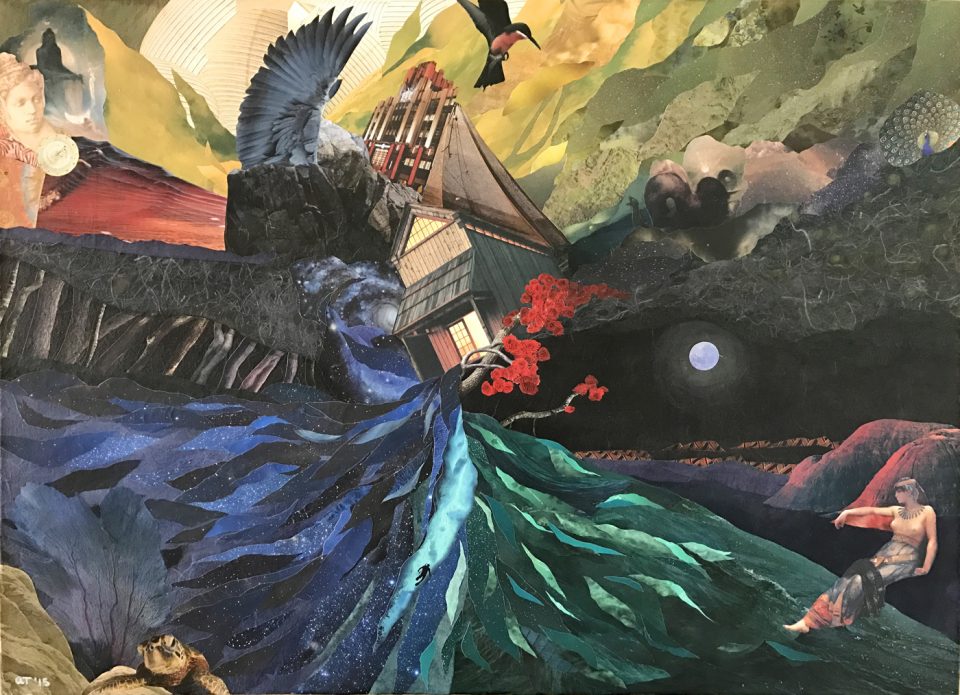
Turbulence | 2015 | 22″ x 30″ | mixed media on canvas
How did you go about making your piece for ArtStreet, After Us?
It was a little different because they wanted to know what I was going to do ahead of time, and I had to put it together loosely as a digital sketch beforehand. I was really nervous, because it was so much bigger than anything I’d done before. I had to build the wooden canvas. Usually I sit back and filter through all these different magazines and books, and whatever elicits some sort of an emotional connection for me, I gravitate to it, put it down, and if it works, it works. With this one, it was harder to use my smaller scrapbook elements because everything was so large. There’s a big tree in the corner, and since there’s no magazine I have with a tree of that size, I printed out little pieces here and there online to make a composite of a tree. I just had to keep in mind what the theme was, which is being us [people] being taken over by nature. In my other pieces, the theme is pretty loose, and it may end up saying something completely different by the time I’ve finished it.
Would you say that nature is the dominant theme in your work? What pulls you toward it?
I just like how organic the textures are—the movement of water especially. And there’s so much symbolism in nature, water in particular. Then there’s the draw to my childhood, because there was so much nature in my childhood that I don’t have quite as much of now. Our family lived in the country, surrounded by fields. When I was around 10 years old, I would take walks out into the field and go fishing by myself. We were always catching anything that moved. My belief is that we truly are connected with every living thing on the planet. And my fear is that right now, it’s like this heartbreaking connection in a way, because the more we learn—the more we know we’re connected, the more we know that we’re ruining things, hurting the world with our presence and our negligence. We’ve lost our connection in some ways, even though it’s unbreakable, but because we’re ignoring it, we’re ruining it. It’s scary, but at the same time it’s comforting, because nature has a way of righting itself. There’s a counterbalance, and maybe it will make up for whatever we’ve lacked. Maybe we won’t fare so well, but I feel like the Earth will right itself.
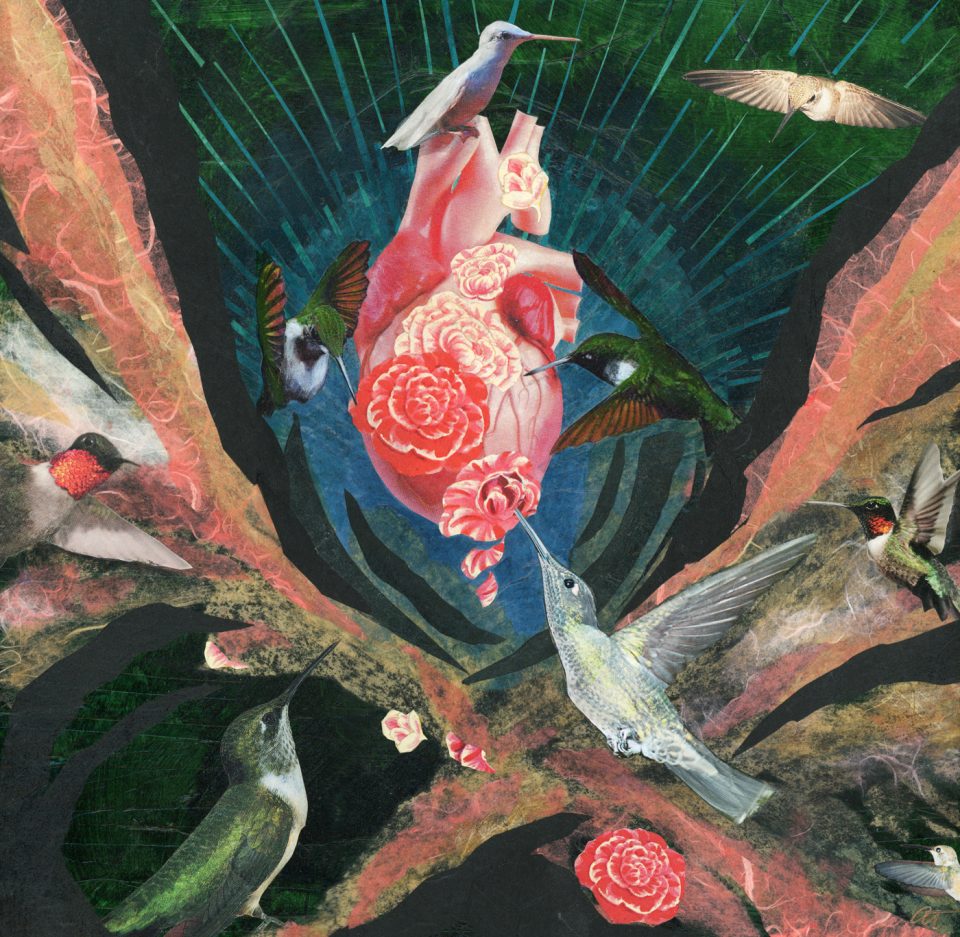
Sweet Heart | 2015 | 12″ x 12″ | mixed media on canvas
How did you begin working in collage?
I went to school for fine arts and I got my BFA, but I really didn’t do anything with it for years and years. I went into graphic design, and I did a few things on the side, but what inspired me to get into collage in particular was the work of Jill Allyn Stafford. She was a board member at 916 Ink, where I do a lot of design work. So I saw that, and I had these little three-by-three wood samples I’d picked up at a thrift store, so I started layering things on them. I think the surrealism and the fantasy themes have always been in the back of my mind—the dream worlds.
I like collage better than painting. I can paint, but I could never do exactly what I want with it. Part of the fun of collage is not knowing where I’m going to be later in the work. It has the element of surprise. I won’t know what a piece is going to mean until two elements suddenly come together. When you’re making a collage, you’re bringing with you the history of whatever piece you’ve just used to the other things on the palette, whereas painting is directing from one source—your mind.
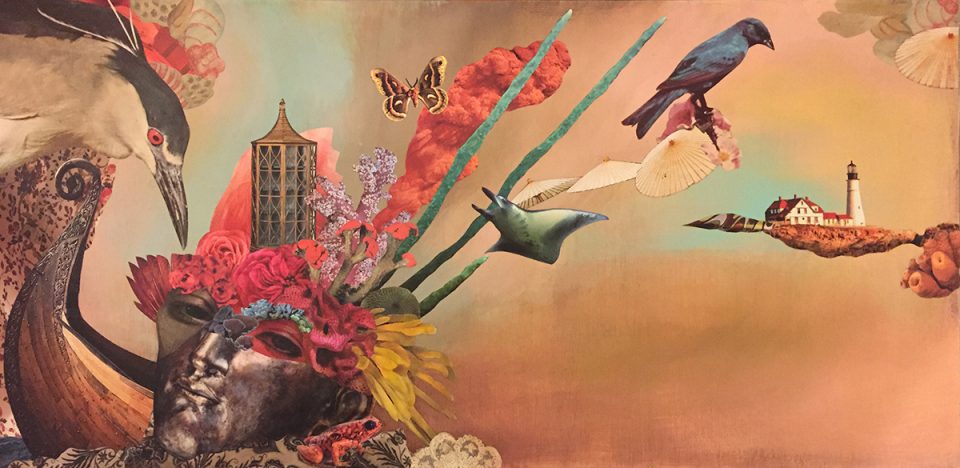
Heady | 2016 | 12″ x 24″ | mixed media on cradled panel board
Do you have a method for hunting down your source material?
I have so many collection items right now that I might have to stop, but usually I have to make a trip. I really like getting pieces from the Time Life series, National Geographic of course, and textbooks are great. I have probably hundreds of magazines and books that I use, but lately, since ArtStreet, or a little bit before, I found Flickr commons, and I use that a lot because I can print to size. If you find the right thing and you want it aged, you can make it look aged. The crackle effects come from a paste, or sometimes it’s layered tissue paper.
Do you have any mood music or media that helps your work along?
I watch bad television, but it has to be a specific kind of TV. Have you ever seen the show Supernatural? Cheesy sci-fi or comic book stuff. Something that would be perfect for the 14-year-old boy, that’s what does it for me. It’s light enough where it occupies only a part of my brain, so the other part can go into dreamland and be automatic. But it’s interesting enough, and a lot of the time there’s weird creatures in there, or something otherworldly. I’ve probably watched every episode twice, I just put it on repeat. The only thing I can’t watch at all while working is comedy—it puts my brain into a completely different kind of rhythm, and everything comes out weird and awful. It’s just something about where my brainwaves land, that puts me in a space where I can create without having to think too hard. When I was little, a big influence was Fantasy Island. That, and we also used to have this Saturday afternoon show that was nothing but dinosaurs, monsters and ghost stories. Anything that has mythology attached to it, or a creature feature of any kind, really drew me in. I guess that’s why those types of shows put me in that right frame of mind, because it just takes me back to my youth. I guess I haven’t changed much.
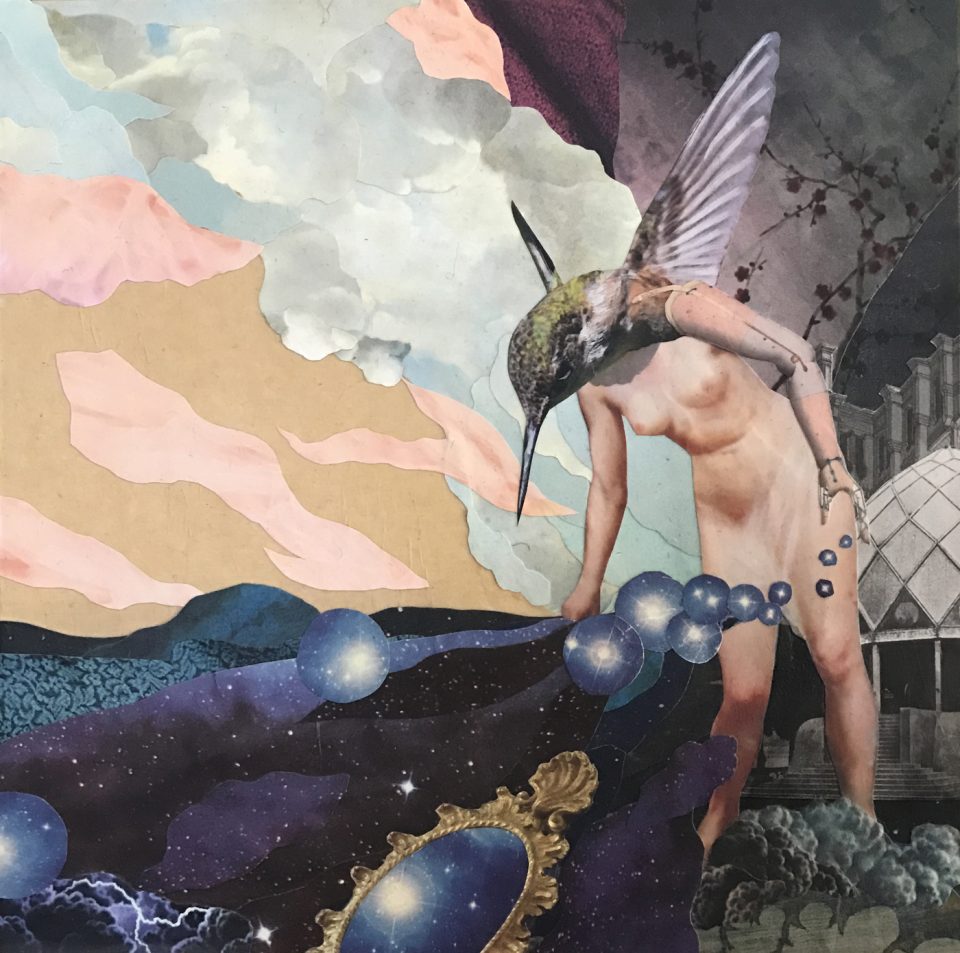
Lady Bird’s Universe | 2017 | 8″ x 8″ | mixed media on cradled panel board
How would you describe the impact of 916 Ink?
Years ago when we started, everybody thought it was going to be a literacy program. And it kind of is, in that there’s reading and writing involved, but what I felt from the beginning that it was going to be, and as it turns out it really is, is kids writing and telling their stories, getting positive feedback and encouragement. You can watch somebody grow, become able to take more chances, have a little more confidence. I swear, you even get a little smarter when you’re allowed to open up, to take things in. You’re not insecure and closed off as much. The kids, more than anything, find this sense of confidence that they didn’t have, and they do better in school and in life. I just posted this the other day, it’s a quote from Rainn Wilson, “If you can tell your story, you can heal yourself.” That’s what’s going on there. I haven’t gone to one of the readings without getting choked up. I’m still fairly new to making art, and I think the biggest thing that encouraged me to start was surrounding myself with people who were positive, encouraging and accepting. That didn’t happen until I started working with 916 Ink. They were great cheerleaders, and they get you to come out of your shell.
Angela Tannehill will be part of the 62 Hues group show at 1810 Gallery, located at 1810 12th St. in Sacramento. The show opens Friday, June 2, 2017, from 6-10 p.m. Tannehill will also be the June guest artist at Studio 10 in Arthouse on R, located at 1021 R. St. in Sacramento. Receptions are first Friday from 6-9 p.m. and second Saturday from 5-9 p.m, with the gallery open on the third Sunday from noon-2 p.m. Find out more at Angelatannehill.com.
**This interview first appeared in print on pages 18 – 19 of issue #240 (May 22 – June 5, 2017)**
In Midtown Sacramento, one local concert series is coming back to help prove that you don’t have to break the bank to have a good time and see top-notch DJs and bands. THIS Is Midtown (referred to by locals as simply “THIS”) is a series of carefully curated block parties that are 100 percent free for all ages to attend and go down on Second Saturdays on 20th Street between J and K, right outside the MARRS Building. The series returns on May 13, 2017, with some heavy hitters in the dance/electronic music world, namely two Brooklyn-based producers/DJs, Bit Funk and JNTHN STEIN, with local support from funk/soul/disco-inspired duo Blush and DJ Satapana. On June 10, THIS will be back at it again with Vancouver-based DJ and EDM producer Felix Cartal headlining, with support from San Francisco duo NRVS LVRS and a DJ set by Jon Reyes (of the Sacramento-based hip-hop/electro group DLRN). Other artists to look forward to seeing perform throughout the concert series are: Little Boots, a popular DJ, songwriter and producer from London (playing THIS on July 8); Luke Million, a master of synths and funky dance beats who will be visiting Sac all the way from Australia (he plays on Aug. 12); and Blu J, a relatively new and somewhat under-the-radar DJ-producer duo that is primed and ready to blow up the international festival circuit (they play THIS’ finale on Sept. 9). Each installment of THIS also features art, vendors, food, beer, cider and a lot more. Events run from 4:30 – 9 p.m. To learn more and to see the full lineups, visit Facebook.com/thismidtown or Instagram.com/thisismid916. Crank up THIS’ 2017 SoundCloud playlist below and get hyped for the parties.
**The write-up above first appeared in print on page 11 of issue #239 (May 8 – 22, 2017)**

Located on the ground floor of the recently completed Warehouse Artist Lofts in the historic R Street district of Downtown Sacramento, the WAL Public Market is a one-of-a-kind gallery, retail and restaurant space that houses seven local businesses: Old Gold, a vintage boutique with handmade goods; local shoemaker Benjamins Shoes; Kechmara Designs, offering Moroccan rugs; Metro Juice Kitchen and Drinkery; record and vintage stores Kicksville and MediumRare Records; and Fish Face, a grab-and-go sushi/poke counter. The gallery portion of WAL Public Market is getting ready to host their first-ever Second Saturday art reception on July 11, 2015, for an exhibit that is appropriately titled First Art Show. The exhibit, which is currently hung and available for viewing, features paintings, illustrations and mixed-media pieces from four artists: WAL resident and 80’s/90’s pop culture influenced illustrator Navid Dehghan; Bay Area artist/sculpture Stephanie Wickizer; Verge’s Bekah Wilson, a painter; and watercolorist Eric S. Wood, who also teaches art at Sac City and Sierra colleges. The reception on July 11 runs from 6 to 9 p.m., and the show will remain up now through August 4. WAL Public Market’s hours are from 11 a.m. to 7 p.m. Monday through Saturday and 11 a.m. to 6 p.m. on Sunday’s. They are located at 1104 R Street.
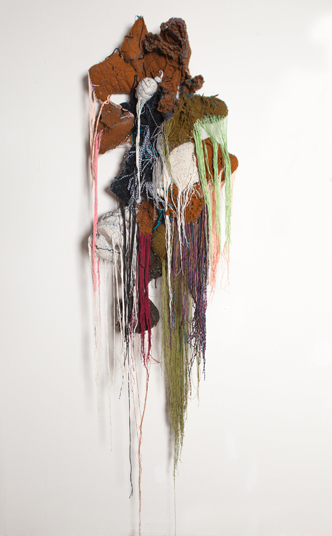
{Stephanie Wickizer}
PodgyPanda Creates Art That Makes You LOL
Gut-wrenching, thought-provoking, nostalgic, arousing, anger-inducing… these are some of the common impressions that artists often seek to evoke through their art. This intentional pulling of heartstrings is either accomplished by means of cognitive antecedents or clear messaging through powerful imagery. It is often argued by art critics that good art isn’t just a pretty picture; moreover, it makes the viewer feel some kind of way. But Richard Kuoch, known in the art world as PodgyPanda, just wants to make you smile. Maybe even chortle or LOL.
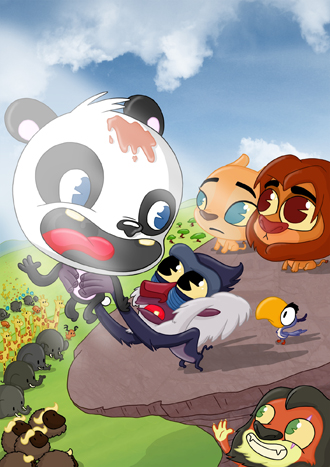
In his first ever solo show in the United States, Kuoch is revealing his newest digital illustration series at Dragatomi in Midtown Sacramento. The series places his cute little characters, familiar to fans of his previous works, into recognizable Disney movie scenes. In one of these pieces, his panda character replaces Ariel as the mermaid bursting out of the foamy ocean and onto a rock while in song. In another, the panda as Tramp shares a single strand of spaghetti with Lady in Little Italy. Another illustration depicts PodgyPanda as Simba from The Lion King being held up by a baboon character over Pride Rock in the iconic birth announcement. You get the idea.
The effect is like being bombarded by adorableness and humor, although people who like to read into things could probably extrapolate some meaning in the theme in regards to pop culture, icons, blah, blah, blah. Kuoch says he just wants the viewer to feel happy. Beyond his little dudes’ unabashed cuteness, his use of cartoonishly vibrant colors also lends to the visually pleasing and uplifting result of looking at his pieces.
A New Zealand native, Kuoch just moved back home to Auckland after a two-year stint in London. While in England, he was lucky enough to land a job at Kidrobot, the famous adult toy company (not that kind of adult toy—the collectible, endearing figurine sort) and was able to bolster his art career to new heights. He has shown his work in the United States in group shows, as well as in Canada, New Zealand and Europe. His first solo show was in Calgary.
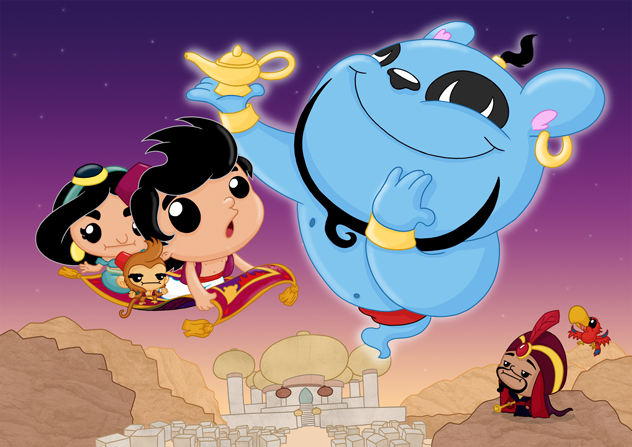
The solo show at Dragatomi opens on Second Saturday, Aug. 9, and will be coming down on Sept. 12, 2014. If you’ve never popped into Dragatomi before (it’s on J Street between 23rd and 24th streets), it serves as the perfect venue for this show. Dragatomi is a gallery and boutique that features toys, apparel, art books, and art inspired by urban pop culture—PodgyPanda fits right in.
Besides his popular digital illustrations, Kuoch also creates logos, drawings on wood or paper, resin toys, and apparel. His updated website launch (Podgypanda.com) is slated to correspond with the solo exhibit at Dragatomi, and his online shop is bustling, though Kuoch says it usually experiences a spike in sales following a show. Exhibit attendees can also purchase his work in person at shows—Kuoch likes to attend his shows so he can meet the people who come to them.
With a background in animation, Kuoch’s cheerful imagination led to the birth of the characters that are depicted in a unique world throughout his work. PodgyPanda is sort of the main character, with a cast of supporting pals. The characters are adorable little chaps in odd situations or locations that support his overall motto about art—“Blink, smile, share.” His father influenced his outlook by being a funny guy that loved to make people laugh, and for Kuoch, making art is all about the importance and contagiousness of happiness.

In addition to sharing his art on his website and at exhibitions, PodgyPanda is all up in the social media, too—Facebook, Tumblr, Instagram, Flickr, Pinterest, Twitter—and Kuoch has participated in Creative Mornings in Auckland, a breakfast lecture series for the creative community which takes place in cities around the world. These rad and inspiring themed talks are available to view online at Creativemornings.com.
“’Blink, smile, share’ refers to an emotion, what I want people to get out of experiencing my art. I try to evoke some sort of feeling, mostly a happy thought worthy of sharing,” explains Kuoch, who hopes to see your smiling face at Dragatomi.
Kuoch’s solo show featuring PodgyPanda will be at Dragatomi, 2317 J Street, from Aug. 9 to Sept. 6, 2014. For more info, visit Podgypanda.com or Dragatomi.com.
Kenny the Dancing Man: Who the Hell Does He Think He Is?
A Japanese proverb goes like this: “We’re fools whether we dance or not, so we might as well dance.” Other adages draw connections between the act of dancing and pure joy, or at the very least a sense of “FUGGIT,” to lessen the blow of mundane, grueling life.
Kenny the Dancing Man, an often shirtless, wacky and mischievous dancing fixture at many indoor and outdoor Sacramento music events, has figured out a way to find happiness in spite of bipolar disorder and the soul-sucking ho-hum of the daily grind. Dancing, you are probably thinking, due to the lead in. Nope. It’s girls.
But dancing gets him center stage in a sea of free-spirited and open-minded girls that will dance, talk and laugh with him. Plus, it’s a good workout (hence the Iggy Pop lookin’ figure), it’s fun and it makes uptight patrons feel uncomfortable—a real perk for Kenny.
I sat down for a Q&A with Kenny the Dancing Man on his way to Concerts in the Park, but it was really a bunch of “A” and not a whole lot of “Q.” Listening to him talk was just as amusing and unusual as watching him dance.

{Photo by Niki Kangas}
What kind of dance were you trained in?
It’s an ongoing thing, like forever! I’m with a ballroom in California where they are training me to be an International Latin Show Dancer! International Latin Show Dancing is a little known world that not a lot of people know. Everyone knows hip-hop, breakdancing. They’re jumping up and down like cockroaches on crystal meth, but it’s for children and teenagers, and when you get older you will never dance with a girl. NEVER. All they’ll do is dance with boys and kiss the concrete. That’s all they will do! If you look at their faces, they’re all young. My world is…samba, paso doble, cha-cha and rumba. We come out as big divas. It’s all about us, Niki; it’s all about us. We love that!
When I go out dancing, I’m practicing what I’ve learned in the studio—I’m practicing International Latin Show Dancing movements.
Girls want to dance with someone fun who doesn’t take a run at them, you know? Or make them feel like a piece of meat at Raley’s. I know that because I was a bartender most of my life, and because I have a background in dancing.
I dance with girls that are looking for boys to dance with. Is that such a crazy thing? I’m not into this bro and man cave crap. I’m into girls. I like girls, guns, God and Corvettes. I want to have fun like Donald Duck and Elmer Fudd, they’re my heroes!
I want to get my own TV show called The Dancing Man Hoochie Mama Show. I’ve got it all figured out. I want it to be like the Dr. Oz or Opera Winfrey Show where you talk about stuff, but I want to have fun, I want to talk about dancing and stupid stuff, I want to throw food at each other, I want to dance and do the weather, and just go nutty, and talk about the cumulus clouds that are accumulating over Yuba City while I dance with a girl.
Where do you dance?
Normally I go to the big outdoor events, like Concerts in the Park or Second Saturday, and I go to Mango’s on Friday because there’s like a thousand girls there…there’s just jillions of them. Sometimes Faces on Friday or Saturday. Other places are too little for me. I need space, and I’m most comfortable when there are hundreds of people. I like to terrorize or torment them, or have fun! With girls like you that like to laugh and have fun. The old people think I’m disgusting and slutty.
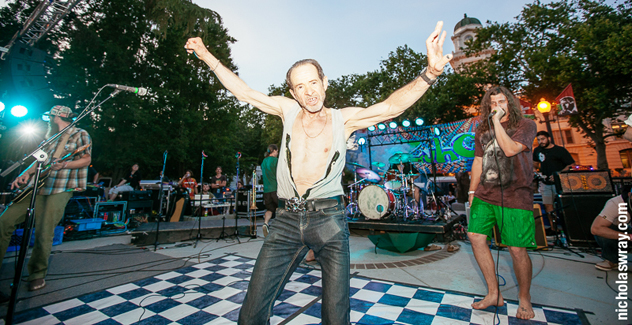
{Photo by Nicholas Wray}
Eh, fuck ‘em.
Exactly! Screw them! I don’t care about them, because I only care about the ones that care about me. The old ones are fat and out of gas, and they see someone like me who comes at them like a bat out of Hell, and they don’t know what to do with someone like me! But the girls jump out at me and do their little hoochie coochie moves, and that’s the whole point. Have fun. We’re all gonna die. Life is short, and life isn’t fair. I believe in doing it now.
Do you work?
I used to be a bartender, but I have a bipolar disorder. I didn’t know what I had, I just knew something was wrong, and I got fired years ago because I couldn’t control it anymore. I was diagnosed with it and I had to go on pills, and I couldn’t work anymore. I felt like strangling people.
I feel like that every day, too.
Yeah! I just wanted to blow them off the Earth with a huge cannon and roll them over with a tank, so I wasn’t suitable to work anymore. But I loved bartending because I got to meet fun, sweet girls like you that made me laugh. I had to go on Social Security and disability, but I needed something to replace the social aspect, which I love so much. So I started dancing.
Why no shirt?
I want to show off this 125 pounds of eye candy! I’ve been working out with weights for 25 years, two or three times a day!
What I really want is television. I want the whole world, millions of people… I want to be on your aspirin bottle. I want to be in your rear view mirror. You can’t get away from the Dancing Man! He’s always there! You can’t escape him!
What is it that you like about the ability to command attention?
The fact that they’re forced to look whether they like it or not. I’m not a mean person, but I’m mischievous. My favorite thing is to find a place where hundreds of people are waiting in line for a show or something, and they’re trapped, and I’ll get out of my car and dance, and they have to look at me! They can’t leave because they want to go to some event—I love that! I like to make them uncomfortable, or freak them out, or irritate them, or make them love me. I like people to look at me and say, “Who the Hell does he think he is?!”
And I say, “Kenny the Dancing Man, for God’s sake!”
Where people gather, you’ll find Kenny. Look for him just about anywhere.
Artist Susan J. Silvester finds a nurturing home in Sacramento
A blue-faced bunny girl clutching a limp, stuffed toy launched an entire series of artwork for Susan J. Silvester that she—and a growing number of fans—adores for its dramatic reflection of her dark, feminine voice.
Animals, imaginary lands, costumes, facial expressions and unusual body forms combine to represent Silvester’s self-proclaimed creepy genre.
The audience doesn’t really know if these forlorn, timeless beings are humans in fuzzy costumes or part human, part animal.
“They are sort of the same,” Silvester says from her home in Sacramento, where she does her digital work when not painting in her Verge Center for the Arts studio space. “I didn’t know that was going to happen but I’m a big fairytale and sci-fi fan (I love Dr. Who), so they’re human but they’re not. It’s creepy. It’s sort of based on medieval costumes that I saw and I learned how to sew. I do them kneeling a lot, so it’s an odd pose, because it’s kind of religious but kids do that a lot.”

Silvester’s first solo show, at Gallery 2110 and the Sacramento Art Complex, will be available to view next month and represents a psychological realm, another space that has to do with deep emotion and feeling. Think Pan’s Labyrinth meets 16th century portraiture.
At first, the art seems so sweet and delicate, and it is, but then it also conjures up feelings of entrapment and childhood confusion.
“I have a female voice, but then, I am a female,” says Silvester. “I just see that in the work, it expresses me. Even though these [faces] are not me they are me, because they are aspects of my personality, pieces of me.”
The first bunny girl was a result of a bad review she received while working on her master’s in painting at Sacramento State.
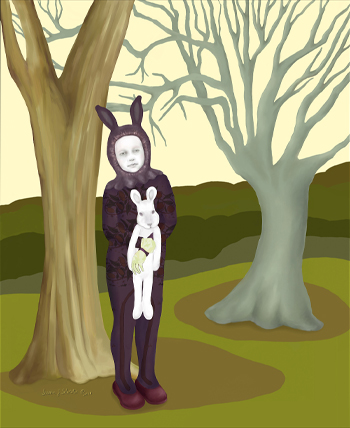
“Basically I got slammed in my review at school, and I got sad so I decided I’m going to draw people how I want to, and so I did,” she says. “I like people as animals. But it’s faux fur, it’s not real. I’m a vegetarian.”
The campus trees, squirrels and overall environment worked as a muse, as did Silvester’s more than 30 years of experience that ranged from Web design to art fabrication and replication animation.
Some of the particulars of these jobs are incredible. Silvester has built massive fiberglass sculptures for the Macy’s Thanksgiving Day Parade, created objects like children’s toys for comic strip Family Circle and designed the Rock and Roll Hall of Fame website.
Her artistic ability and dark humor came in handy when she worked on Pee-wee’s Playhouse and the Back to the Future ride at Universal Studios. Perhaps more impressive, however, was her work as an art fabricator in New York—her home state—for leading pop artists Robert Rauschenberg, Tom Wesselmann, Marisol and Lynda Benglis.
“As an artist, especially in New York, you just survive,” she says of the experience. “That was all sort of dark and wacky, so my work is still playful and dark.”
While working on the Back to the Future ride, Silvester decided to go back to computers and stop making large models as she had been for sets and other artists.
“I probably created enough toxic waste to last 100 million years,” she says. “I made a set that was 30-by-70 feet out of that foam that never breaks down and it was huge and disgusting. There were these huge bugs that came out of it. It was horrible. I said that’s it, I’m done with this, and then transitioned into computers. It was a good call.”
Silvester feels her digital work is almost more difficult than painting because she sees every flaw magnified.
“It’s really labor intensive and a lot of people don’t understand but this is all hand drawn,” she says of her digital work. Sometimes I’ll scan in my drawing but then I still have to paint it. I touch every part of that freaking piece. And when you flatten things (in Photoshop) then you have to fix it. I’ll still print something out and will see something and no one else will but I know it’s there. When I started painting, I kind of missed the ‘undo.’”
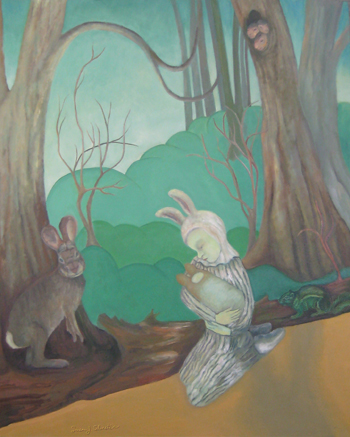
Silvester paints using mixed media, acrylics and oil. She has also recently incorporated her sculpting skills into her solo genre, sculpting bunny girls using clay and covering them with felt. If she completes the pieces, she may also include them in her show.
“I’m trying to show where I started and where I’m going so it’ll be interesting and help round out the show,” she says.
When she’s not in her studio or feverishly fixing every line and dot on her digital drawings, Silvester is teaching at the Art Institute, a job that has helped her go beyond “just surviving” as she did years ago in New York.
“Now I can do my art because I have that [the teaching],” she says. Silvester teaches color theory, drawing and design at the institute and also instructs senior classes at the Natomas Art Center in Folsom.
The art scene in Sacramento is also more her pace, Silvester says, after honing her career in both New York and Dallas.
“Since I moved here in 2001, the art scene has changed so much,” she says. “It’s expanded but it’s still a core group. I like knowing the different artists and seeing what they’re doing.”
She adds that attending school in Sacramento and having a studio at Verge has also positively affected her work and given her the confidence and feedback she needs.
“It has been a good place for me and we just kind of share ideas and critiques, so it’s really great for artists.”
Check out Gallery 2110 this July to see more of Silvester’s creations. A reception will be held July 13, 2013 from 6 to 9 p.m. Visit Susansilvester.com to follow her work.
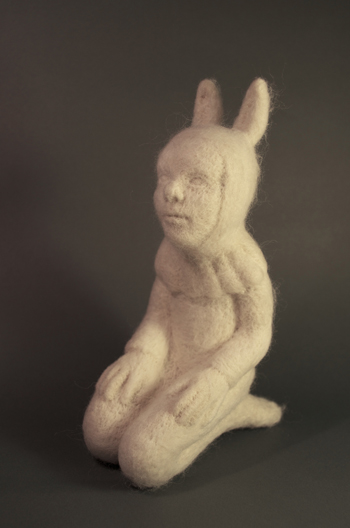
Sacramento artist taps into a childhood obsession for his latest show
Pop art in the ‘60s and a growing critique of consumer culture at the end of modernism led art into an aesthetic of mash ups, parodies and pastiche. Pulp art, comic books, baseball cards and the developments of global branding strategies all collided into Wacky Packs, a series of stickers that mocked consumer goods through parody, produced by Topps Trading Company in 1967, and originally illustrated by Art Spiegelman (writer/artist of the graphic novel Maus) and Norman Saunders. Fast forward 45 years, the influence of these seemingly benign stickers can be found in the artwork of Bruce Gossett.
Gossett’s works have been seen at a few select galleries around Sacramento and sold at various car shows over the past decade, but his current work draws specifically on the playfulness and base impulses of a childhood fascination: Wacky Packs. His artwork follows this tradition of plagiarism and parody, using existing advertisements and iconography from the custom car world to create tongue-in-cheek fine art works that connect an adult world of masculine custom hot rods with the juvenile playfulness of puns and gore.
Gossett has developed his art over the years working with multiple graphic forms, all of which have influenced his relationship to the canvas, his preferred medium. He’s printed T-shirts, rock and car show posters, stickers and done customized airbrushing and detailing on cars. He once tried his hand at stand-up comedy, only to realize he didn’t like the spotlight and has since found his calling in a small, insulated shed-studio in the back yard of his West Sacramento home. Gossett spent years going up and down California, attending car shows, selling his works: T-shirts, posters, stickers, fine arts. And the influence of this culture has been foundational to his development as a graphic and fine artist.
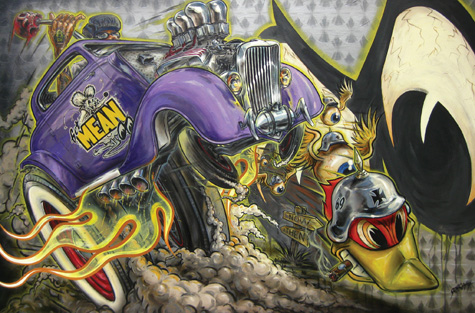
But it’s not just car culture in general that Gossett finds alluring, it’s a specific subspecies of that broader category, those custom car creators, the seedy underbelly of that combination of Detroit automobiles and California counter culture. This DIY renaissance of the automobile, the material object that transported America from farmlands to urban spaces, appears in the work of Gossett as an image set to be appropriated and employed according to a particular set of aesthetics.
These counter culture references are manifest in his current work, the Speed Equipped series, which will be shown for Second Saturday in October at So-Cal Speed Shop on Del Paso Boulevard. The Speed Equipped show focuses specifically on parodies of logos for hot-rodding companies like Moon Speed Equipment, from which the show takes its name. Gossett has created a set of produce brands with the low-brow humor of those Wacky Packs, and he has even been tapped by Anti-Hero Skateboards and local John Cardiel to create the artwork for a pro-series of decks. Gossett’s works span multiple culture groups and as such he’s a significant contributor in the battle against bourgeois ideals and high-art. He’s a working class artist, and that’s just why we like him.

Tell me about your new show, Speed Equipped.
I was obsessed with Wacky Packs in the ‘70s. They were parodies of national products. You know, household products, Windex and stuff like that. They basically mocked them and made fun of them. They were stickers in chewing gum packs. I remember kids covering their closet doors with them, much to the chagrin of their parents. I got obsessed with them. It was funny. The imagery was so base and crude, like it was painted with a broomstick or something. The humor was just great.
Finally, I thought about it one day, and I’ve never seen parodies of the speed equipment. I’ve always been immersed in the car thing, and I thought why not make fun of the icons of the rod and custom world. It’s something I’ve been working on over a two-year period. I’d like to get them out there and get them seen. I think there’s a generation that grew up in the ‘70s around Wacky Packs, skateboarding, punk, irreverence and that audience totally would get it.
I’m also showing some of my Builders Series. It’s the guys that build cars that I dig, but they’re the new generation of builders as opposed to the old generation. It’s not fair cars and Sunday drives, lawn chairs and car shows. There’s a new generation of builders and hot-rodders and the vast majority of them are coming out of the skateboarding world.
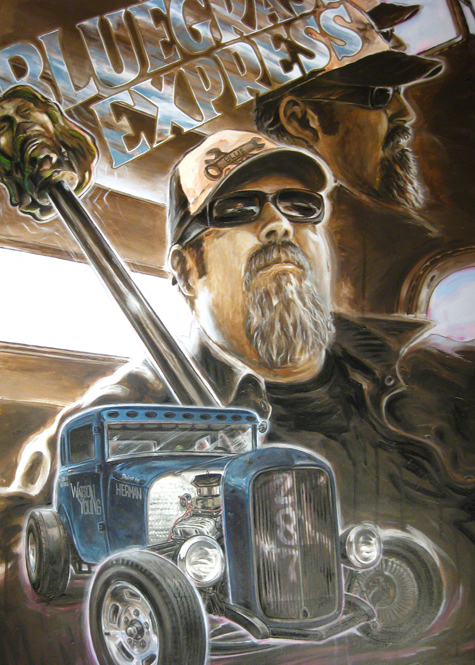
Can you explain how that series is different for you? How it’s a change of direction from your previous work?
The Builders Series is more photo-based. Sometimes it’s the vehicles they build, and I’ll focus on that. Other times I’ll start introducing images of the builder, so it’s a little more personal. It’s difficult, painting portraitures and capturing likenesses. It’s more representational, photo-realistic, but I’m making them psychedelic, lots of drips, lots of maneuvering of the surfaces so that you know it’s a painting as opposed to an airbrushed, photo-realistic work.
What’s the best and worst parts about being an artist?
Being locked in the studio is boring, frankly. There’s nothing more I’d like to do than be in the studio for 10 hours and paint. But by that eighth hour, I’m probably pretty sick of it. The days are weird. There are times when it’s fun; there are times when it’s work. I think I like the beginning and the end best. I like when it hasn’t been touched and I first lay in backgrounds, working from the rear forward. You’re establishing a mood when you first start, so it’s fun. Anything is possible. And in the end, it’s always nice to finish something. You’re happy it’s out of the way.
Once I finish something, I don’t want to look at it for a while. Then a week later I’ll obsess over it for about a week, and then I’m usually pretty good with it. For that reason I always have half a dozen paintings going at any given time.
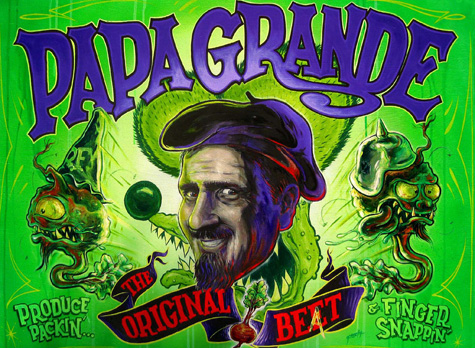
How do other forms, graphic design, T-shirt printing, etc., influence your work?
These are like complex graphics really. My knowledge and experience over the years from different industries, sign painting, pin-striping, graphic applications for hot rods, on vehicles, I get a lot of influence from those other forms. To produce really clean graphics you work rear forward. Do your infill colors and then hit the black lining. It’s really the cleanest way of producing stuff.
When did you decide to take your artwork seriously?
After about the first year, I took it seriously. I started in 1989. I’ve always designed stuff and did things with paint. We stole Testors paints from Thrifty’s and pay for a ten-cent ice-cream cone, and we’d customize our skateboards. I’ve always been around cars, my family was in the car industry. I wanted to get away from it, so I actually tried my hand at stand-up comedy. That didn’t go real well. Then I took a class at City College, the material was stale but I took to it real easy. I realized not only that I had an aptitude for it, but that I enjoyed it. And I was useless in other areas. I just had a short attention span, and the art thing seemed limitless. It really took off in the mid 90s when I really started pursuing more of a car based or an automotive bend.
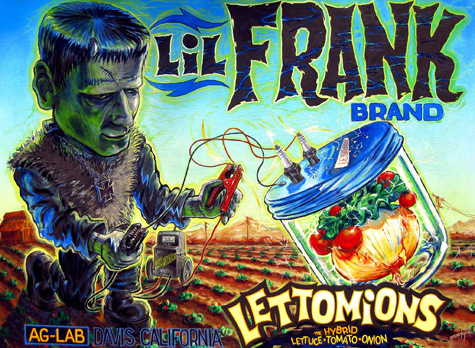
What is it about cars and hot rod culture that you find so alluring?
I’ve always had old cars. My first car was a 1972 Chevelle I fixed up before I had my license. It seemed like a meathead world to me. You’ve got to understand the ‘80s. It was the dark days for this car thing. There was a renaissance in the ‘90s, and I got introduced to Big Daddy Roth and that whole world. It was like the thinking man’s hot rod. It was the Bad News Bears, and I missed that from when I was a kid. I realized there were these weirdo hot-rodders, and it totally clicked with me. I decided to get back into it. I built a few cars. I just jumped in.
Even if it doesn’t have cars, I still call some stuff hot rod art. It’s just got an aesthetic. Even a portrait or something, just the way the paint’s moved, it screams hot rod to me. I like a lot of aggression in my art, a lot of action and movement.
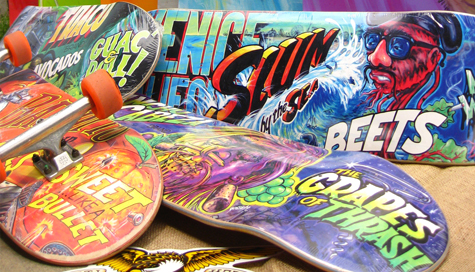
How’d you get hooked up with Anti-Hero Skateboards and John Cardiel?
Cardiel saw my Fresh Ripe and Delicious show at A Bitchin Space. He saw the preview in the University Art window, and he totally got it. He totally remembered the Wacky Packs. He said, “I’ve got six riders and I want you to personalize a piece for each one.” I got where each rider was from, their hometown, where they were born. I did a bit of research and developed ideas. It was crude, tounge-in-cheek, vulgar, but it was a skateboard company, no holds barred, and he totally got it. He’s a squirrel; he’s cooler than shit. It was the most perfect client you could ever ask for.

Bruce Gossett’s Speed Equipped opens at So-Cal Speed Shop in Sacramento on Oct. 6, 2012 from 4—9 p.m. The Second Saturday reception will take place the following week, Oct. 13, 2012 from 5—10 p.m. While there, check out a preview of Gossett’s Builders Series. For more info, contact Gossett via http://www.facebook.com/BruceGossettStudios.
“Where fashion meets art,” says the slogan of Forum Boutique, a brand new shop at 2310 J Street, Suite C (just upstairs from our Submerge office!), which celebrated its grand opening this past Second Saturday. Spend a couple minutes with the two young, passionate ladies behind Forum, Alma Campos and Nerina Edwards, and their slogan starts to make more sense. “The idea is basically we are marrying our two genres,” Edwards recently told Submerge. “Alma is a fashion guru mastermind, and then I’m the artist.” Forum carries everything from Edwards’ handmade jewelry (her necklace design that says “Midtown” is really popular; she can even create custom pieces that say whatever the client desires) to their own line of handmade organic soaps and skincare products, from re-discovered home décor to super cute clothes from brands like Dolce Vita, BB Dakota & Jack, Local Celebrity and more. “I know a couple boutiques carry Local Celebrity men’s T-shirts, but it was hard to find the ladies tees, so I brought those in. And I’ve got some pretty fabulous shoes on the way too,” Campos said with a huge I’m-not-supposed-to-tell-you-what-brand sort of smile. The two agreed that their grand opening was a success, stating that because they had a DJ and artist (DJ M4nik and artist Oscar Padilla) painting and playing music out on their “front porch” as well as a hairstylist from Lush Salon, it really drew people in. “It was extremely successful. We had tons of people and a good atmosphere,” recalled Edwards. “It was a great turnout from friends, family and the community,” Campos added. “It was such a great attraction as far as the DJ, the live art, the hairstylist, just everything going on outside.” When Submerge stopped in during the grand opening, the place was bustling with activity and we even scored a cute owl ring for our boss-lady Melissa Welliver. We were beyond stoked to see the building we’ve been in for nearly a year finally being used to its full Second Saturday potential, and we’re looking forward to Second Saturdays from here on out. To learn about our awesome new neighbors, visit Forumboutique.com or just stop in and say hi. They are open Monday through Thursday from 11 a.m. to 7 p.m. and on Fridays and Saturdays from 10 a.m. to 7 p.m.

j27 Art Gallery
If you’ve driven through or walked down J Street past the 2700 block lately, you’ve more than likely noticed the new sign outside what used to be Papi’s Pizza that simply says, “Art.” Meet j27 Art Gallery, a brand new gathering space co-owned by area artists Susan Rabinovitz and Michael Shane. Rabinovitz, known for her hand-forged jewelry, met Shane, an abstract painter who also owns a shipping and delivery company, at the Sacramento Art Complex where they both had studios about a year-and-a-half ago. “We’d always discussed doing something together,” Shane said during a recent conversation with Submerge. “So about two months ago when I started looking at commercial space I called her up and said, ‘Are you still in?’ and she said, ‘Yeah!’ so we came over and looked at this space. We signed the lease two days later.” Shane pointed out that they are aiming to break the “Second Saturday only” mold and that they want to be “an everyday gallery.” Every weekend there will be something going on, not just on Second Saturdays, be it a live art exhibition, live local music, meet and great sessions with artists and more. Currently represented at j27 are paintings and jewelry from Shane and Rabinovitz as well as a slew of other regional artists’ work including abstract paintings by Gayle Rappaport-Weiland (June’s featured artist); photography from Monica Lunardi and Allister Oliver; fused glass art by Nicole Krohn; sculpture work by Molly Brown, Paula Swayne and Angela Ridgway; paintings from Donna Marie Sterpe as well as cartoonist Eric Decetis’ world-renowned work and much more. Shane pointed out that j27 is proud to be the only gallery selling Decetis’ original art, whose cartoons have graced the pages of countless publications. All in all, j27 has an excellent mix of art found in all sorts of mediums. It’s easy to get sidetracked when in the space, as there are so many eye-catching things to look at. “We’re trying to be very picky about the art that we hang,” Shane said. “We want to have an upscale environment and we want to be the place where people come to buy fine art. But, we want it to be a fun place too; we don’t want it to be stuffy. If you come in, you’re going to hear music, we’ll talk to you about the art, it won’t be dead cold and quiet. It’s important to carry that real high-end stuff, but you don’t have to make it, you know, cold and museum-like.” Learn more about j27 and the artists behind it at j27gallery.com or just stop in. They’ll be open every day starting at 11 a.m. (1 p.m. on Sundays).
-J. Carabba
Our good friends at Spanglish Arte (located at 905 23rd Street) are excited to be hosting the second annual Piñata Festival on Saturday, June 11, from 12 p.m. to 8 p.m. Sacramentans of all ages and backgrounds are invited to experience this free and ever-so-vibrant event set to take place on 23rd Street between J and I streets. It’s a unique celebration of piñatas through art, live music, food and free workshops. The entire block will be lined with custom colorful and avant-garde piñatas, vendors of all sorts (folk art, custom jewelry, culturally infused food, etc.) and Papel Picado to “not only bring out the mood of celebration, but it will also create a vibrant experience for everyone who attends,” said Spanglish Arte owner Mari Arreola in an official press release. Local artist Danny Schieble, known for his “Tapigamy” sculptures, will be onhand, creating his own piñata masterpiece for spectators to view. Also, for this year’s event, Arreola has invited private individuals, organizations and local businesses to sponsor or bring out their own piñata in the shape of their logo to enter it in a special contest. A portion of the proceeds from every sponsored piñata will benefit the Washington Neighborhood Center. There will free piñata workshops throughout the day, too, if you’re feeling crafty. Basically, this is the block where you’ll want to spend your time this Second Saturday, as it will have it all: art, live music, dancing, great food, good company, what else could you ask for? For more information about Spanglish Arte, visit Shopspanglish.com






